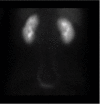Management of localized prostate cancer and an incidental ureteral duplication with upper pole ectopic ureter inserting into the prostatic urethra
- PMID: 19145274
- PMCID: PMC2615107
Management of localized prostate cancer and an incidental ureteral duplication with upper pole ectopic ureter inserting into the prostatic urethra
Abstract
Ectopic ureters are rare congenital malformations of the renal system that most commonly present in females. It is extremely rare to encounter an ectopic ureter in an older man undergoing radical prostatectomy. We report herein a case of a 66-year-old man with prostate cancer and a complete duplication of the left renal collecting system, with an upper pole ectopic ureter and associated normal functioning renal parenchyma entering into the prostatic urethra. This anomaly was incidentally discovered on preoperative magnetic resonance imaging of the prostate. Open radical retropubic prostatectomy and a left ureteroureterostomy were performed.
Keywords: Ectopic ureter; Prostate cancer; Prostatectomy; Prostatic urethra; Ureteroureterostomy.
Figures






Similar articles
-
Intraoperative Management of an Incidentally Identified Ectopic Ureter Inserting Into the Prostate of a Patient Undergoing Radical Prostatectomy for Prostate Cancer: A Case Report.Medicine (Baltimore). 2015 Aug;94(32):e1261. doi: 10.1097/MD.0000000000001261. Medicine (Baltimore). 2015. PMID: 26266359 Free PMC article.
-
[Lithiasis in complete ureteral duplication and prostate cancer: combined surgery treatment].Arch Ital Urol Androl. 2003 Sep;75(3):158-60. Arch Ital Urol Androl. 2003. PMID: 14661394 Italian.
-
Left ectopic ureteral insertion into seminal vesicle detected after robotic assisted laparoscopic radical prostatectomy.Urol Case Rep. 2022 Jul 31;45:102173. doi: 10.1016/j.eucr.2022.102173. eCollection 2022 Nov. Urol Case Rep. 2022. PMID: 35991216 Free PMC article.
-
Upper Pole Heminephrectomy Versus Lower Pole Ureteroureterostomy for Ectopic Upper Pole Ureters.Curr Urol Rep. 2017 Mar;18(3):21. doi: 10.1007/s11934-017-0664-0. Curr Urol Rep. 2017. PMID: 28233227 Review.
-
[Ectopic ureter in prostatic urethra. Unusual discovery in an adult].Arch Esp Urol. 1995 Oct;48(8):843-6. Arch Esp Urol. 1995. PMID: 8526544 Review. Spanish.
Cited by
-
TRUS-guided drainage of the ectopic ureter entering the prostatic urethra and TRUS-guided transurethral neo-orifice formation using holmium laser.J Ultrason. 2018;18(74):255-264. doi: 10.15557/JoU.2018.0037. J Ultrason. 2018. PMID: 30427132 Free PMC article.
-
Experience with robot-assisted laparoscopic surgery of the lower ureteral segment in adults.J Robot Surg. 2012 Sep;6(3):223-30. doi: 10.1007/s11701-011-0296-1. Epub 2011 Jul 28. J Robot Surg. 2012. PMID: 27638276
-
Intraoperative Management of an Incidentally Identified Ectopic Ureter Inserting Into the Prostate of a Patient Undergoing Radical Prostatectomy for Prostate Cancer: A Case Report.Medicine (Baltimore). 2015 Aug;94(32):e1261. doi: 10.1097/MD.0000000000001261. Medicine (Baltimore). 2015. PMID: 26266359 Free PMC article.
-
Recognition and Management of Ectopic Ureterocele During Robotic Assisted Laparoscopic Radical Prostatectomy.Urol Case Rep. 2016 Jun 7;8:15-7. doi: 10.1016/j.eucr.2016.05.002. eCollection 2016 Sep. Urol Case Rep. 2016. PMID: 27313987 Free PMC article.
References
-
- Campbell MF. Anomalies of the ureter. In: Campbell MF, Harrison JH, editors. Urology. 3rd ed. Philadelphia: WB Saunders; 1970. pp. 1487–1542.
-
- Schlussel RN, Retik AB, et al. Ectopic ureter, ureterocele, and other anomalies of the ureter. In: Wein AJ, Kavoussi LR, Novick AC, et al., editors. Campbell-Walsh Urology. 9th ed. Philadelphia: Saunders Elsevier; 2008. pp. 3383–3422.
-
- Savino M, Musquera M, Palou J, et al. Lithiasis in complete ureteral duplication and prostate cancer: combined surgery treatment. Archivio Italiano di Urologia e Andrologia. 2003;75:158–160. - PubMed
-
- Funahashi Y, Kamihira O, Kasugai S, et al. Radical prostatectomy for prostate carcinoma with ectopic ureter; a case report. Nippon Hinyokika Gakkai Zasshi. 2007;98:580–582. - PubMed
-
- Lepor H. Radical retropubic prostatectomy. Urol Clin North Am. 2001;28:509–519. - PubMed
Publication types
LinkOut - more resources
Full Text Sources
